Table of Contents
ToggleIntroduction
With the first BIOS version dated to late September 2001 and the first reviews dated to early October 2001, the EpoX 8KHA+ was one of the very first KT266A boards available on the market. The PCB Layout remained unchanged compared to its predecessor 8KHA with the KT266 chipset. Only the northbridge fan was changed from AAVID to Cooler Master and, of course, the newer VIA KT266A chipset is now installed.
Unlike many previous EpoX models, the 8KHA+ was not available with onboard IDE RAID. An updated version with an altered PCB and IDE RAID (8KHA2) was planned and shown on Comdex 2001, but it didn't make it to the market. Shortly after the release of the 8KHA+, two more budget oriented KT266A boards with a smaller PCB were released, which are the 8KHAL and the updated 8KHAL+. The differences in short:
- 8KHA+ = VIA KT266A/VT8233 chipset
3-phase VRM, six PCI slots, diagnostic LEDs. active chipset cooling, ATA100 IDE, large PCB
- 8KHAL = VIA KT266A/VT8233 chipset
Budget offering, smaller PCB, 2-phase VRM, five PCI slots, no diagnostic LEDs, passively cooled northbridge, CPU ratio and voltages only configurable via DIP switches
- 8KHAL+ = VIA KT266A/VT8233A chipset
Updated version of the 8KHAL with slightly altered PCB. Newer southbridge with ATA133 IDE. No DIP switches anymore, BIOS settings largely similar to 8KHA+
The EpoX 8KHA+ is a very OC-friendly motherboard, but was also praised for its stability right from the start. Its main competitor (especially in terms of overclocking options) was the Abit KR7A, which was released roughly two months after the EpoX board.
To keep up with Abit's well received KT266A offer, EpoX released a beta BIOS in the End of November 2001, which introdiced a 4:3 FSB:MEM divider and a configurable FSB of up to 210 MHz. This divider allowed to run very high FSB speeds while keeping the memory speed in regions that memory sticks of that time could manage.
At the same time, there were rumors that also 1/5 and 1/6 dividers for PCI were included, to keep PCI and AGP clocks within spec at FSB speeds of 166 and 200 MHz. Since there's a lot of contradictory information on this topic in old forum posts and the like, we'll look into this as well.
Gallery
Specifications and Features
Chipset:
- VIA KT266A (VT8366A) Northbridge
- VIA VT8233 Southbridge
CPU Support (with latest BIOS):
- Athlon Thunderbird (ALL)
- Athlon XP Palomino (ALL)
- Athlon XP Thoroughbred (all FSB266 models up to 2600+)
- Duron Spitfire (ALL)
- Duron Morgan (ALL)
- Duron Applebred (ALL)
Memory Support:
- 3 DDR DIMM slots, up to 3GB total
Expansion Slots:
- 1x AGP slot (1,5 / 3,3V) up to 4x
- 6x PCI slots
Connectors (internal):
- 2x IDE (UDMA100)
- 1x Floppy
- 4x USB 1.1
- 3x 3-pin fan connectors total (1x CPU, 2x chassis)
Connectors (external):
- 2x PS/2
- 2x COM/RS-232
- 1x Parallel Port
- 2x USB 1.1
- 3x 3,5" Audio Jacks (Line-Out, Line-In, Mic)
- Gameport
You might have noticed, that I didn't mention the audio chipset specifically, as I think far better solutions than the old onboard chipsets are readily available for little money. Very commonly recommended are the Creative Soundblaster Live! cards for example, which offer fantastic compatibility with our beloved old games and sound far better than any onboard solution of that era.
I also don't list (from a retro-gamers perspective) useless connectors and features like IR, Smartcard- or Wake-on-LAN connectors and so on.
Overclocking Features:
- Adjustable Multiplier (BIOS) from x6 to x15
- Adjustable FSB (BIOS) from 100 to 200 MHz in 1 MHz steps
- Adjustable VCore (BIOS) from +- 0,100 V in 0,025 V steps
- DDR Voltage (BIOS): up to 3,20 V in 0,10 V steps
Apart from the initial FSB selection of 100/133 MHz via jumper, the 8KHA+ offers a completely jumper-free setup experience. Multiplier, FSB as well as voltage settings can all be done from within the BIOS. Although the “JCK1” jumper lets you set the initial FSB to 100 or 133 MHz, the FSB can be adjusted from 100 to 200 MHz in 1 MHz increments in the BIOS, regardless of the jumper setting. More on the function of this jumper can be found at the end of the “System Setup” part of this review.
Documentation, Downloads, Drivers
Another iconic brand from back in the day that closed doors many years ago, is EpoX. Unlike Abit for example, it is not an easy task to find downloads and information on EpoX mainboards. In terms of BIOS downloads, I recommend this thread on voodooalert.de:
There are several BIOS versions available for the 8KHA+ as well as changelogs for them.
For documentation, you should also find most manuals there:
https://www.elhvb.com/mobokive/archive/epox/manuals/index.html
Just use Ctrl+F on that site to “navigate”, most of the time there are several versions of the manual for each model available and the naming is not exactly “uniform”. The manual for the 8KHA+ in particular can be found in this subdirectory:
https://www.elhvb.com/mobokive/archive/epox/manuals/KT266-KT266A/index.html
Please note, that the aforementioned site only offers downloads for older EpoX Models. For documentation of “more recent” EpoX motherboards you have to look elsewhere, like here for example:
https://www.manualslib.com/brand/epox/motherboard.html
Regarding CPU support you can find the info here: https://www.cpu-upgrade.com/mb-Epox/index.html
I already use this site for a long time and I always found the info to be very accurate. I cannot remember that I had a motherboard, that was not featured there. Great site.
To obtain drivers, take a look at this site: https://soggi.org/drivers/drivers.htm
It offers driver downloads for a huge share of old chips (network, storage, chipset, etc.),
To sum it up: using a motherboard of a manufacturer that is not around anymore might not be as straightforward as using an Asus or Gigabyte motherboard, for example. Especially with Epox motherboards you will have to search a little bit longer for everything you need to build your system. But I think it is worth the time, because EpoX released a number of very good motherboard models, which can be a solid foundation for your retro-build.
Design & Layout
Epox did quite a good job with the PCB design of the 8KHA+. Apart from the common issue of that time period, that the AGP cards blocks access to the memory slots, there is only one major issue with the layout. The ATX power connector is located to the lower left of the CPU socket.
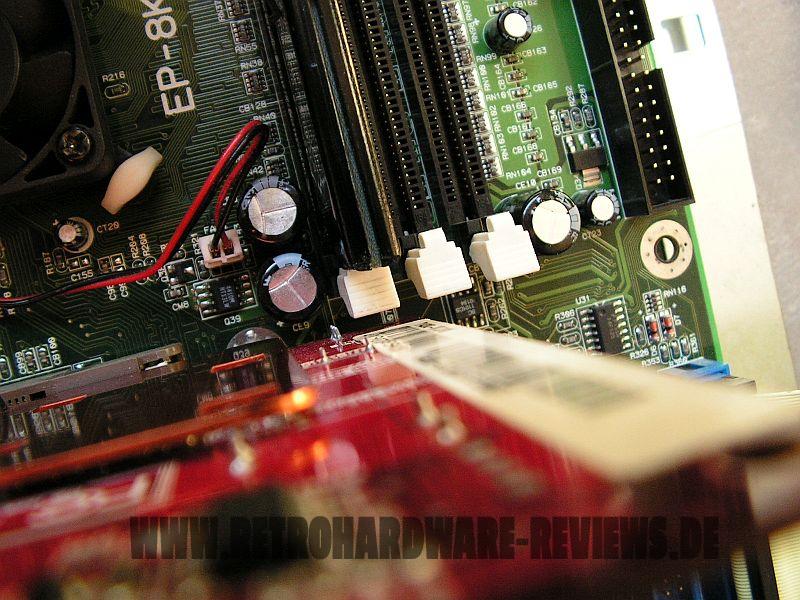
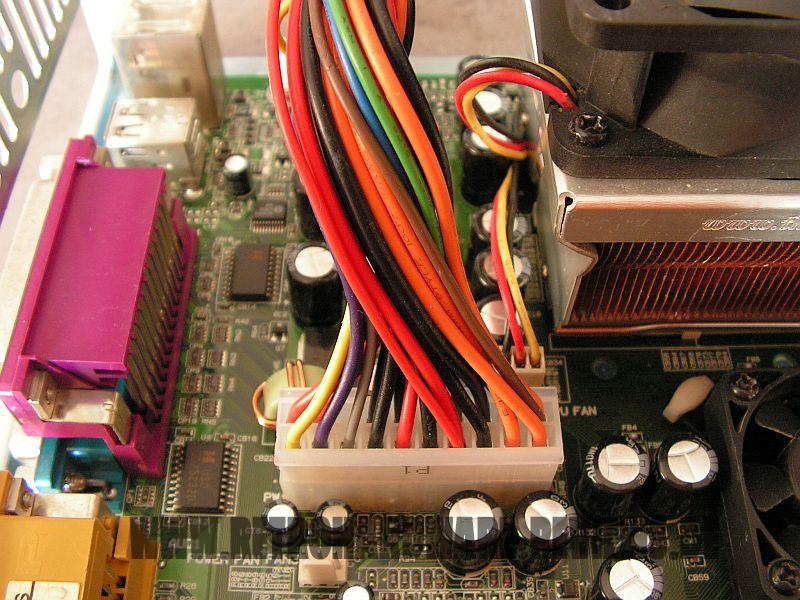
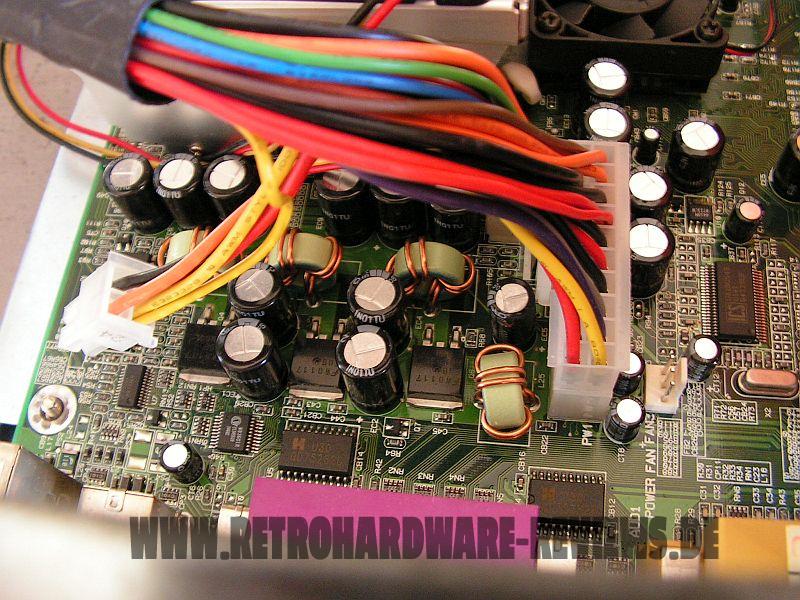
Fortunately, with most coolers, there is enough space available to route the ATX power cable above the CPU socket. But still, it affects the airflow for the hot VRM area of the motherboard.
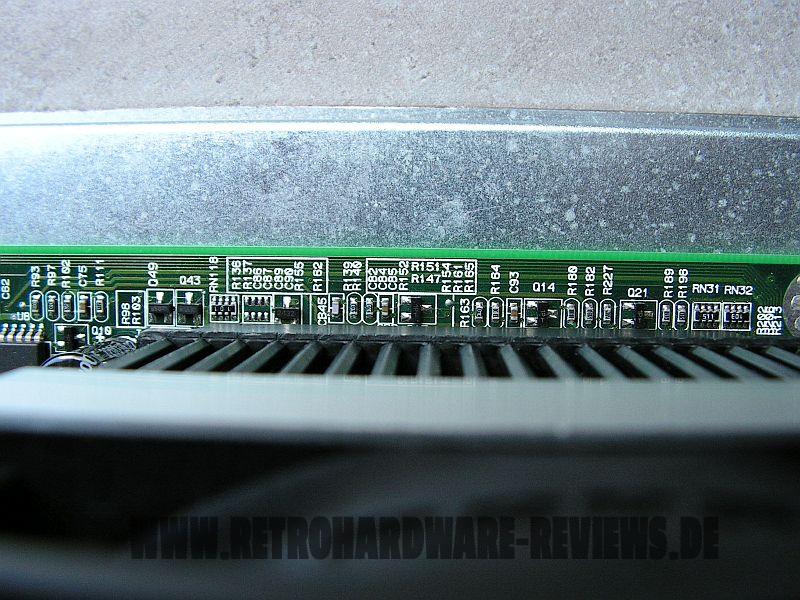
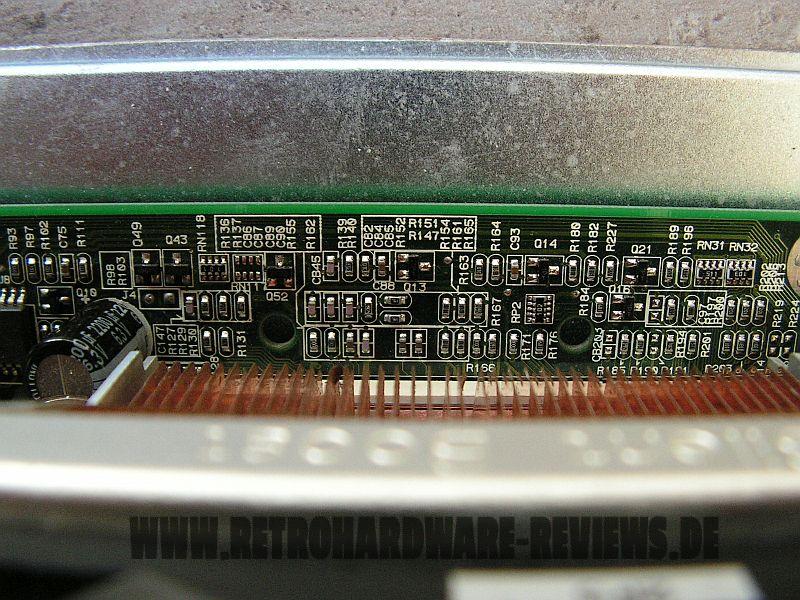
The CPU socket is oriented horizontally and keeps a generous distance to the top of the board. The way the socket is oriented and the available space around it should allow the installation of most Socket A coolers.
To the left of the CPU socket, pretty tall capacitors are installed ex-factory. Since these are not low ESR types, they can be replaced by standard Panasonic FR 2200/6.3V caps, which are far less high. This makes the installation of coolers with a 3-hole bracket much more easy. On my board, pretty much all the capacitors were defective anyway, so of course I replaced them right away.
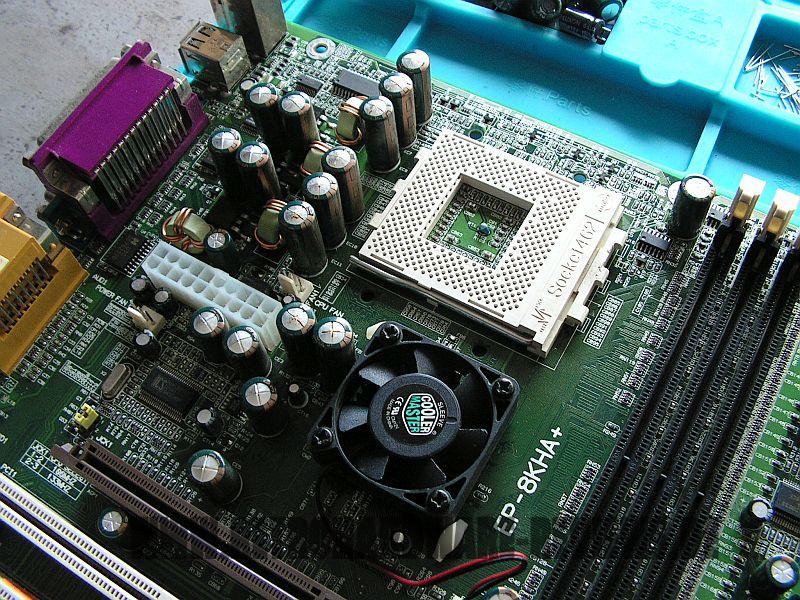
Blown Stock Caps
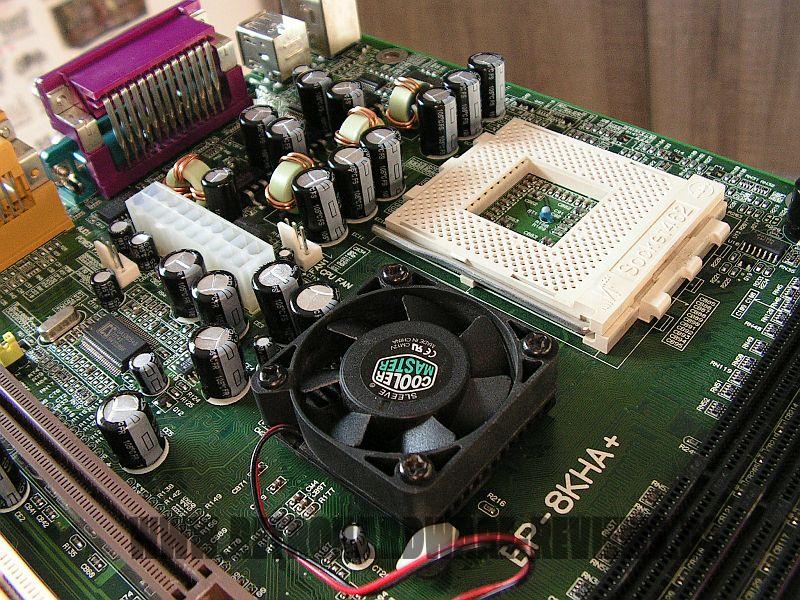
New Panasonic FR Capacitors
I tested the following eight CPU coolers regarding compatibility:
- Thermaltake Silent Boost K7
- Cooler Master HHC-001
- Swiftech MCX 370
- Alpha PAL 6035
- Alpha PAL 8045
- Smartcooler 60mm
- Arctic Cooling Copper Lite
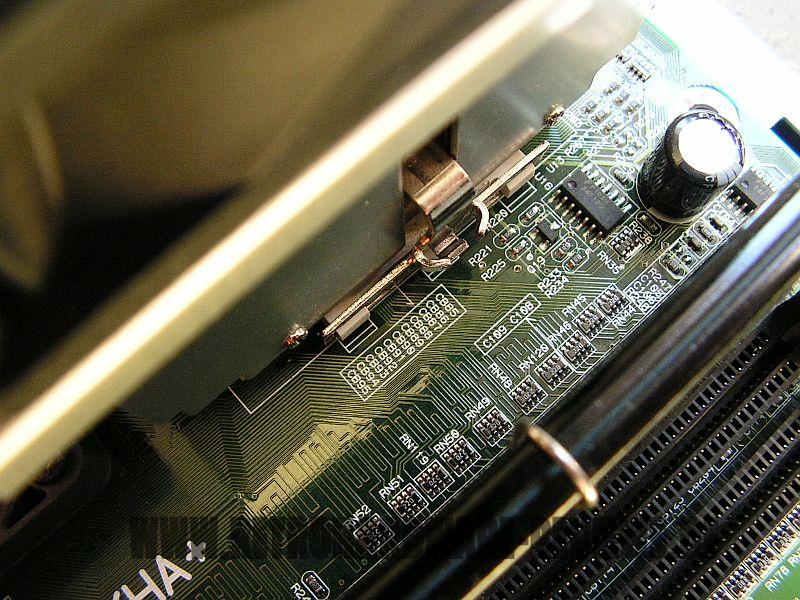
All of the above coolers installed fine and easy, even the “problem child” Cooler Master HHC-001 fits well. The Arctic Copper Lite is one of the coolers that definitely installs easier with the smaller caps next to the CPU socket, as the mounting clamp is now easier to access. Usually, the cooler would touch the stock capacitors and make installation a good bit tougher.
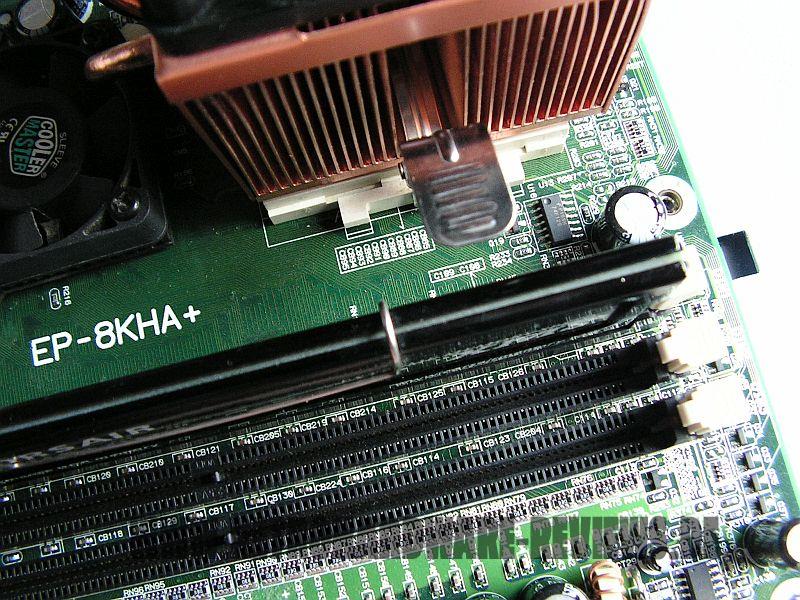
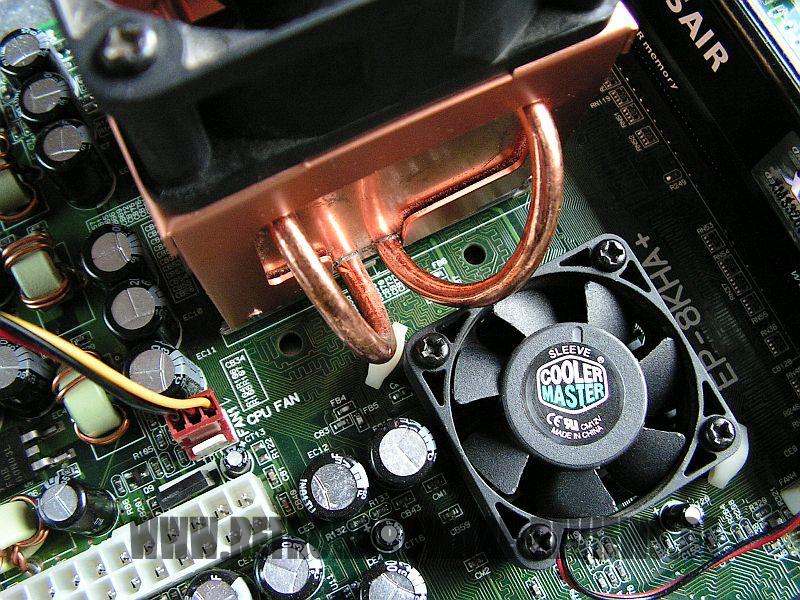
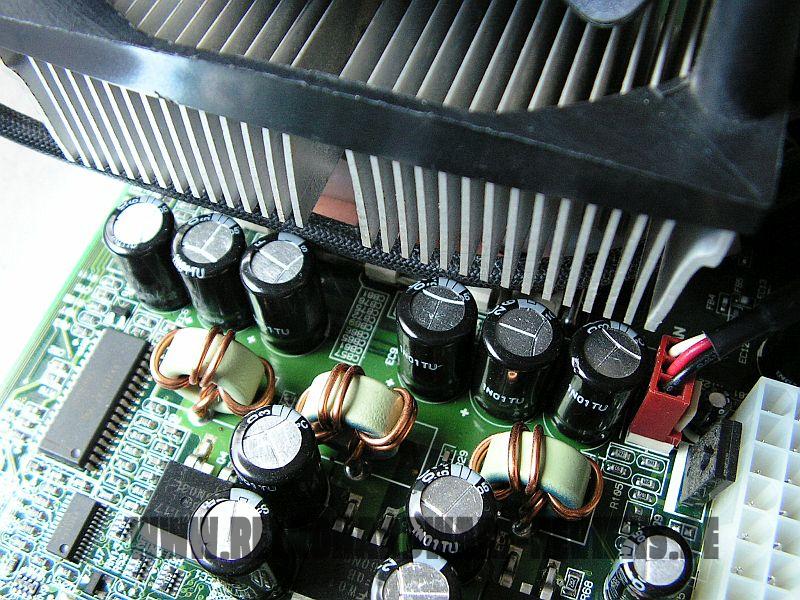
The largest cooler that I tested, is the Alpha PAL 8045. It also fits without issue, but you have to be a bit careful with the small SMD parts above the CPU socket. Some of them are placed very close to the holes where the screws go through with this type of cooler mounting mechanism.
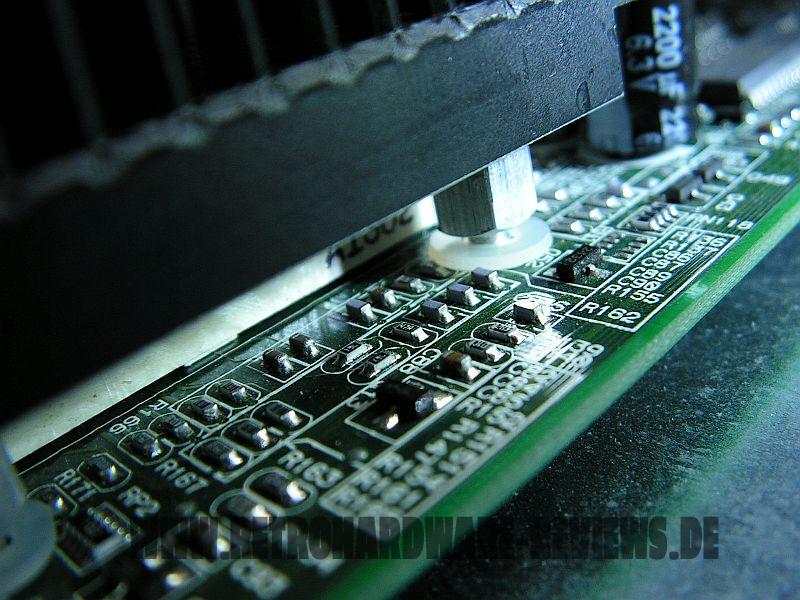
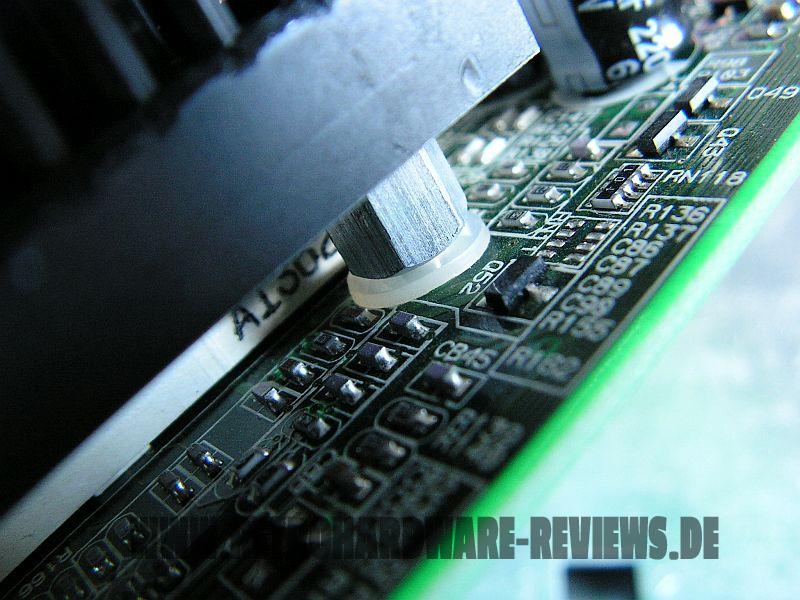
The layout of the board's lower half is very well done. Up to and including PCI #5, even very long expansion cards like Voodoo 2s do not cover any important parts. IDE and floppy connectors, as well as the front connectors and the diag LEDs are nicely placed at the edge of the PCB and easily accessible. The board offers two 3-pin headers for casefans, which are placed perfectly for the connection of a front- and a rear fan. Only if you install expansion cards that are longer than the PCI slots themselves into PCI #5 and PCI #6, you won't be able to replace the CMOS battery without removing one of the cards. But because of the way the PCI sharing is done, you will most likely not run into this kind of problem.
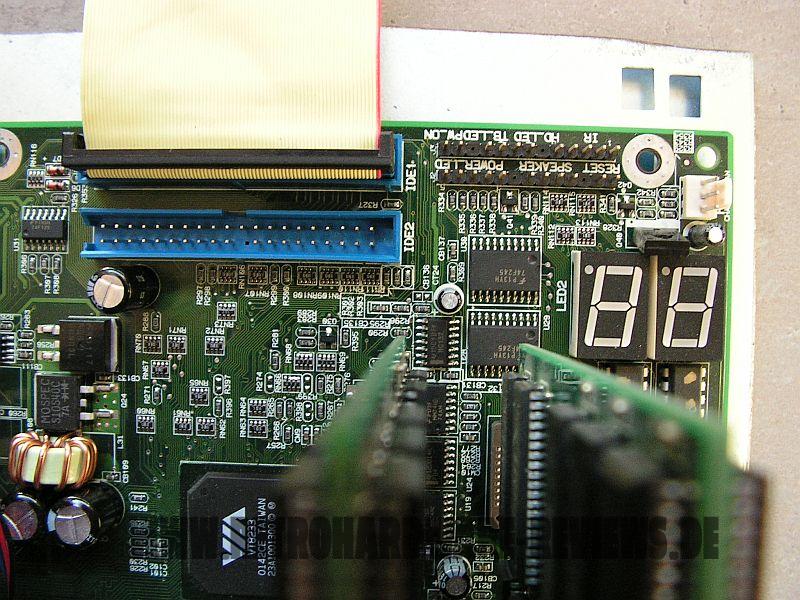
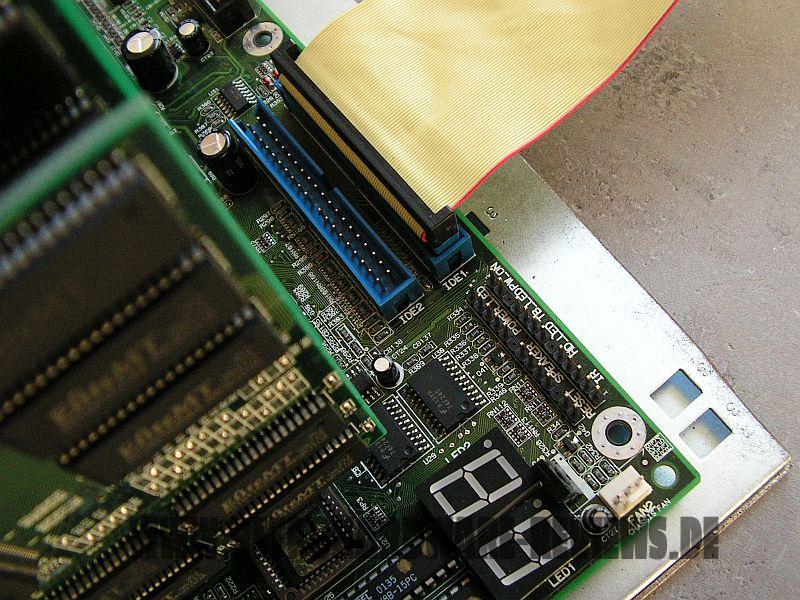
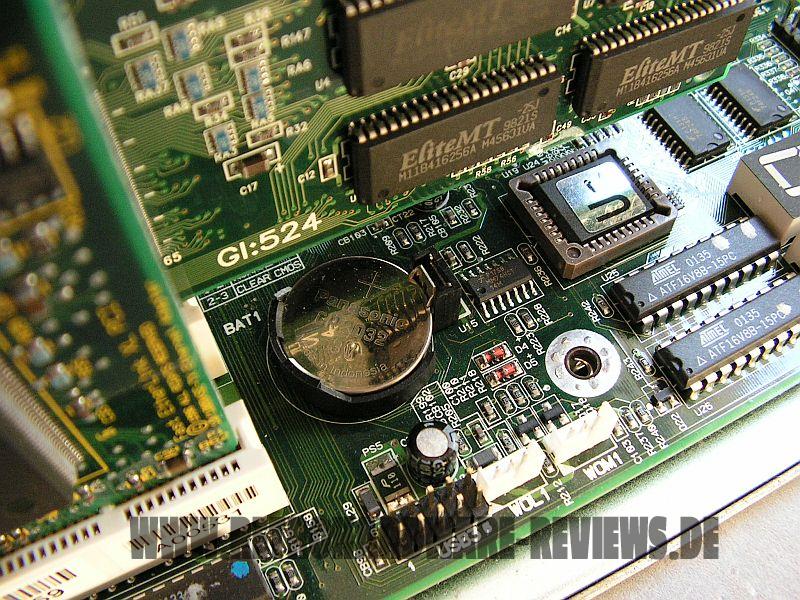
Test-System and Parts
Baseline Setup:
- CPU: AMD Athlon Thunderbird 1200C (FSB133)
Because I want to compare 1st Gen Socket A mainboards to their DDR follow-ups I have to use a CPU, which is available in FSB100 and FSB133 versions with the same clockspeed. Since I sadly don't have a Thunderbird 1400 B at my disposal, I will use the Thunderbird 1200 for my reviews and comparisons of these boards, which I have in the “B” (FSB100) and “C” (FSB133) version.
- RAM: 1x Corsair CMX512-3200C2 (XMS3202v4.2) = 512MB PC400 CL2
This Corsair XMS stick should allow the tightest timings at 266 MHz DDR and its size of 512MB is the perfect choice for Windows 98SE.
- VGA: MSI Geforce 4 TI4200-VTD8X
To remove any GPU bottleneck for testing, I chose a Geforce 4 Ti as the primary graphics card for my test setups. The Geforce 4 Ti series are also known to pull a lot of power from the AGP port, so that possible problems in that department can also be revealed. It is also somewhat period correct and a good match for a high performance retro-machine that should be able to run late Windows 98SE games without any issues.
- VGA2: 3dfx Voodoo 5 5500 AGP
Many people consider the Voodoo 5 5500 the perfect card for (Win9x-) retro gaming. The Voodoo 5 benefits from a beefy setup, so a powerful Athlon Thunderbird or early Athlon XP is the perfect match for this card.
- Audio: Creative Soundblaster Live! (SB0060)
Creative's Soundblaster Live! can be found in many retro-machines. It offers great sound, perfect Win98SE compatibility and is still widely available for reasonable money. It was also known to cause problems with VIA-based 686B southbridges using old BIOS revisions and VIA chipset drivers. All this should be history at this point, but double checking on pontentially affected mainboards is still not a bad thing to do.
- LAN: 3Com Etherlink XL PCI
Just a good, reliable choice for networking. All legacy Windows versions all the way up from Win95 have built-in drivers for it, which is also a huge “plus”.
- HDD: Western Digital WD200BB (20GB 7200RPM)
No special intention behind this drive, it is just “there” and still works fine.
Additional Hardware for certain Tests:
- Silicon Image Sil3512 SATA Controller & Samsung PM871 128GB SSD
These two will help me measure the PCI bandwidth.
- Hitachi Deskstar T7K500 (500GB 7200RPM)
This drive will tell us, how big we can go with the onboard IDE connectors and how the performance is like.
- 2x Voodoo 2 12MB (SLI)
A pair of Voodoo 2s is a must have for any retro-machine, that doesn't feature a 3dfx card as the primary VGA solution. They offer compatibility to older Glide games and can be used with any more powerful primary graphics card. It is an important thing to know, how well these perform and if there are differences between all the available Socket A chipsets of that era or even between boards using the same chipset.
Drivers used:
- Chipset: VIA Hyperion 4in1 4.56v
- Geforce 4: nVidia Forceware 43.45
- Voodoo 5: Amigamerlin 2.9
- Voodoo 2: FastVoodoo 4.6
- SB Live!: Some driver from my archive, not shure 😉
- 3Com NIC: Windows 98SE preloaded driver
- SATA Controller: Some driver from my archive, not shure 😉
System Setup and Usage
The EpoX 8KHA+ was a joy to setup from start to finish. Since there were no jumpers or DIP switches to configure (except for the JCK1 jumper, which I'll get to later), the CPU setup was done in no time. On first boot, the board started with the FSB set to 100 MHz, the necessary settings could then be made directly from within the BIOS. Afterwards, I configured all chipset and memory settings for best performance, which resulted in a memory configuration of DDR266 CL2 2-2-5 1T with 4-bank Interleaving enabled and "System Performance" set to “Turbo”. This worked right away and proved to be stable throughout all testing.
The second step before the actual system setup is always the installation of the expansion cards. Thankfully, Epox included an INT-routing table in the manual, where the sharing between the PCI slots is clearly visible:

The information we get here, is, that PCI #4 and PCI #6 are shared, as well as PCI #3 and PCI #5. The next piece of necessary information can be obtained in the subpage “PnP/PCI Configurations” of the BIOS, where we can see which onboard devices allocate their IRQs on which INT line, by selecting the options "INT Pin 1/2/3/4 Assignment":
- INT-A: AGP
- INT-B: free
- INT-C: onboard audio
- INT-D: USB controller
Based on this combined information, we have two free INT lines available once the onboard audio is disabled (along with other unused onboard devices like serial and parallel ports, etc.). These sharing-free slots will be used by the SB Live! and the SATA controller; the Ethernet card will be sharing its IRQ with the USB controller(s), resulting in this setup:
- PCI #1: free
- PCI #2: SATA controller
- PCI #3: SB Live!
- PCI #4: Voodoo 2
- PCI #5: Voodoo 2
- PCI #6: 3Com NIC
This configuration proved to be completely trouble-free. The subsequent benchmarks with the Voodoo 5 also showed no problems at all.
When I was done with my testing, I wanted to take a closer look at the 1/5 & 1/6 dividers this board is said to have, as well as the “JCK1” jumper. But before we even begin, let me tell you this up front: I cannot recommend using either 166 MHz or 200 MHz FSB with this motherboard (although at least FSB166 should be somewhat possible).
For the test, I first removed all expansion cards and the hard drive. I then started by setting the JCK1 jumper to 133 MHz and the FSB to 166 MHz in the BIOS. In the “Advanced Chipset Settings” section, I set “System Performance” to “Normal”. the DRAM speed to 133MHz (which is a 1:1 FSB:MEM divider), timings to “Auto” and the command rate to 2T. With the CPU Multiplier lowered to 7x, this resulted in a CPU clock of 1166 MHz, with a 166 MHz CL2,5 3-3-6 2T memory configuration.
I restored my Win98 image and was able to install the chipset- and graphics drivers without issues. To get a hint if the AGP clock runs at a stock 66 MHz (which would proof the presence of a 1/5 divider), I fired up the Final Reality benchmark and did a bus bandwidth test. And although the CPU clock was lower and the memory timings were also much slower then in my regular test before, the measured bandwidth was roughly 4% higher compared to my result of the regular benchmark session before.
To investigate this further, I wanted to bench the SSD on the SIL controller to see, if the SSD speed increases over what I measured during the regular test. This should be the case, if the PCI Bus got overclocked by the increased FSB.
But when I tried to boot with the SATA controller installed, the system got stuck where the controller usually detects the connected SSD. I quickly doubled checked, if everything works fine at a stock 133 MHz FSB - and yes, the SSD got detected instantly. In my opinion this finally proves, that there is no 1/5 divider.
I decided to do some further testing in this direction, though. Firstly, I raised the FSB to 167 MHz to see if the divider maybe kicks in a little later - which was not the case. After this, I lowered the FSB to 160, 155 and then 150 MHz, where the SATA controller finally started working. I got a nice increase of ~15/30% on the Read/Write values of the SSD, although the PCI performance on the 8KHA+ is not the best in general (which we'll come to later) and also the SB Live! was not in the system. The Soundblaster card always lowers the PCI performance by a small margin when installed.
To draw a better picture of the AGP performance with various FSB speeds, I redid the Final Reality Bus Bandwidth test with the stock 1200 MHz (9x133) CPU speed and memory timings lowered to those, that I used for the faster FSB settings. CPU speed and memory timings definitely have an impact on the result, so please keep in mind, that all three additional results with the faster FSB speeds have a slightly lower CPU clock. These are the results:
| CPU / Multi / FSB | Bandwidth | Suspected AGP Clock | Suspected AGP overclock | Performance Gain |
|---|---|---|---|---|
| 1166 MHz (7x166) | 323 MB/s | 83 MHz | 25,76 % | 8,39 % |
| 1163 MHz (7,5x155) | 321 MB/s | 77,5 MHz | 17,42 % | 7,72 % |
| 1168 MHz (8x146) | 302 MB/s | 73 MHz | 10,61 % | 1,34 % |
| 1200 MHz (9x133) | 298 MB/s | 66 MHz | 0 % | 0 % |
As visible above, all FSB-overclocked configurations show a better AGP bandwidth, despite the lower CPU clock. This also displays clearly, that there is no 1/5 divider implemented (or to be precise 2/5 for AGP..). I also tried setting the "DRAM Speed" to 100 MHz in the BIOS, to check if the divider has some kind of “hidden activation” linked to this setting. In short: The table would look exactly as seen above, just with different absolute results.
Since with FSB166 we already have a hefty 41,5 MHz PCI clock, I did not try to boot higher FSB speeds into Windows or do extensive tests how low I can go with the memory timings. With such high PCI clocks, it is very possible that the hard drive gets damaged and I prefer to avoid that 😉
Nevertheless, I succeeded to get a POST with higher FSB speeds and the hard drive disconnected. It seems, that the chipset itself is able to go all the way up to 200 MHz, but the board has problems to run the memory at such high frequencies. Perhaps the signal gets to noisy or something like that.
With 180 FSB and DDR360 I got a POST, but the system froze after a few seconds in the BIOS. Higher memory voltages did not help, but the DDR400 stick is definitely not the limiting factor here anyway. Maybe raising the I/O voltage would help, but that is not possible on the 8KHA+.
Interestingly enough, the board POSTs with FSB200 and it is "stable" enough to let me navigate through the BIOS. I put “stable” in quotation marks, because the keyboard reacts very laggy with FSB200, sometimes keystrokes get ignored. It definitely feels “unsafe”. The reason I got a POST with FSB200, is, that EpoX implemented a hardwired 4:3 (FSB:MEM) divider for 200 MHz. The memory gets clocked to 150 MHz (DDR300), regardless of the DRAM 133MHz setting, which translates to a 1:1 FSB:MEM divider at all other FSB speeds.
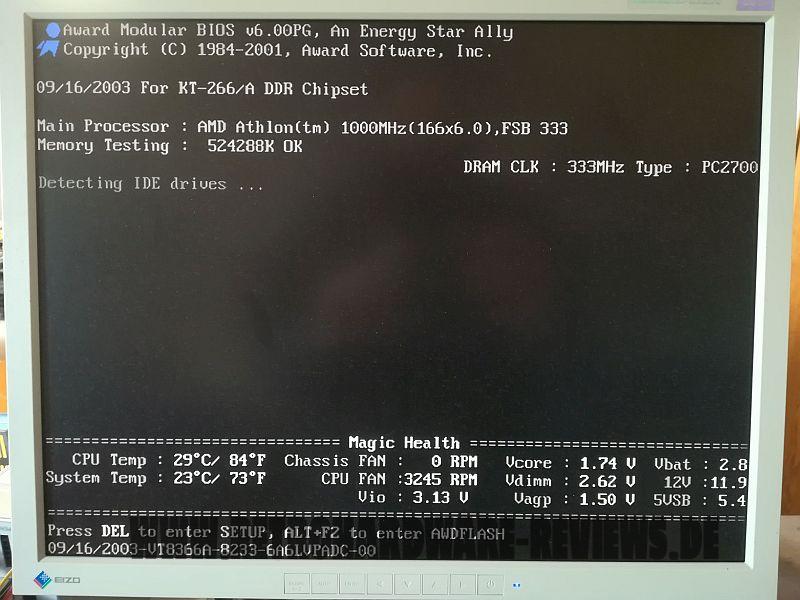
FSB166
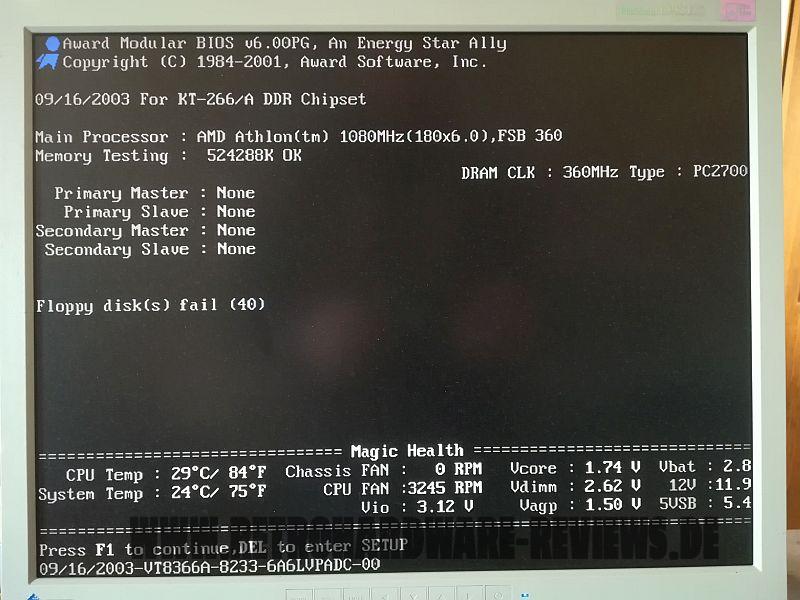
FSB180
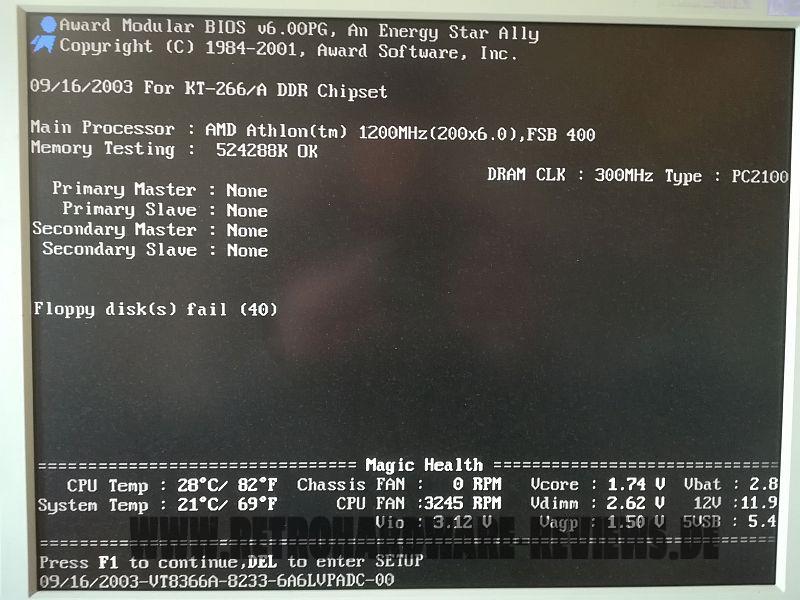
FSB200
One interesting thing I found out during the OC tests, is a hidden (or unadvertised) feature of the "JCK1" jumper. In general, it lets you select the initial FSB of 100 or 133 MHz. This also sets (as expected) the PCI divider to 1/3 if jumpered to 100 MHz - so if you plan to run 133 MHz+ FSB speeds, you should definitely set the jumper to 133 MHz.
The interesting part, however, is, that this jumper does not always behave the same way. If the previous POST was successful, it just resets the FSB and sets it to whatever you jumper it to (100 or 133 MHz). If the board did not POST successfully before because of a too “optimistic” FSB setting, it also resets the complete BIOS (apart from date/time)!
In case the regular “Reset CMOS” jumper is blocked by a PCI card, you now have a secondary “Emergency Reset Jumper” to chose from 😉
Benchmarks
Synthetic Measurements
Before we get into the 3DMark and gaming benchmarks, let's have a look at some theoretical numbers. These synthetic tests will exhibit the differences between the several chipsets and boards better than any game benchmark and provide us with "background information" that might be of use in understanding the timedemo results later.
Memory Performance: AIDA64 Cache & Memory Benchmark
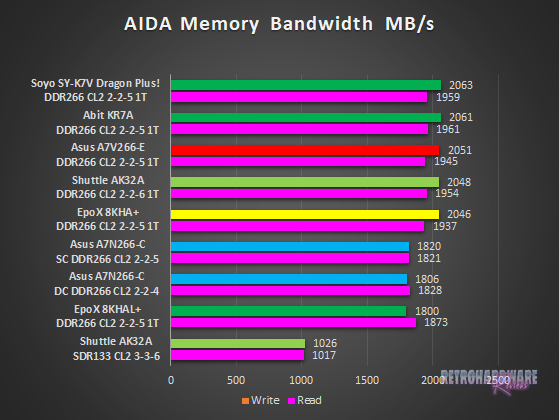
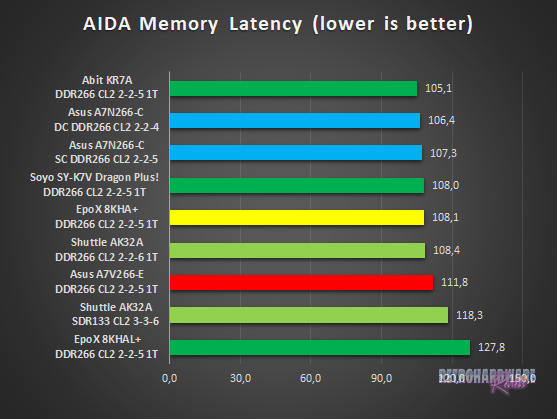
The EpoX 8KHA+ performs average in these first memory-related benches, no sensations of fails here.
Application Performance: 7-Zip
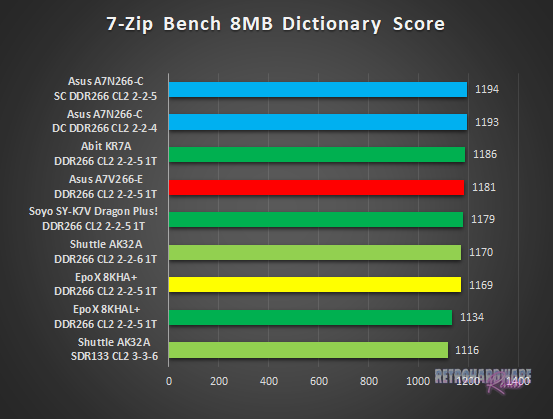
The performance in the 7-Zip bench is a little on the low side. It even falls slightly behind the Shuttle AK32A, although the EpoX board has a tiny advantage in CPU clock and memory timings.
AGP Performance: Final Reality Benchmark
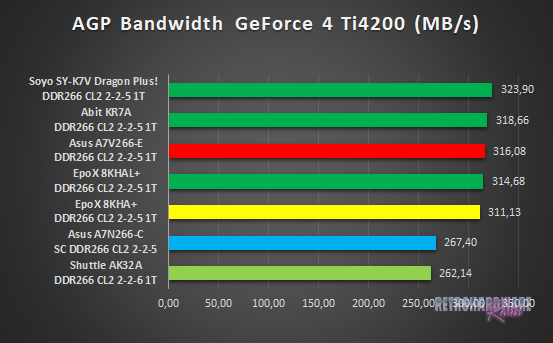
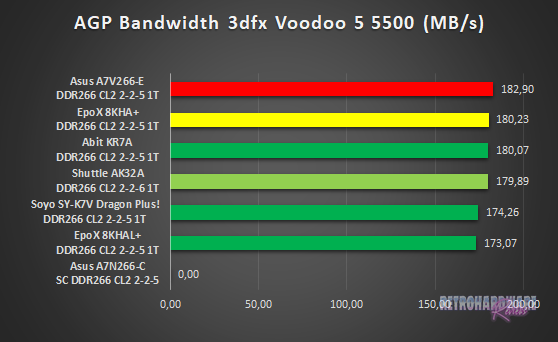
AGP bandwidth with Voodoo 5 installed is quite good, which puts it in second place right behind the Asus A7V266-E. The measured bandwidth with the nVidia card is slightly lower than on most other KT266A-based boards, but nothing worrisome.
AGP and PCI Performance: 3DMark 2000 and ATTO
3DMark 2000 as a whole is very focused on TnL and is by far not as interesting for retro-hardware comparisons as its predecessor. Its “High Polygon Count, 1 Light” test, however, is another good way to measure the AGP performance. In opposite to the Final Reality test, the general system performance is also somewhat of importance. The benchmark was executed with the Geforce 4 Ti installed.
To measure PCI performance, I installed a Windows 98SE compatible SATA controller with a Samsung PM871 128GB SSD connected into the system. For the bench, I chose 1024 to 4096 KB block size and picked the overall best values for the read and write throughput. This test will show, which maximum performance can be expected with fast storage options like SATA or SCSI and maybe gives a hint, if the chipset might be good for Voodoo 2 cards.
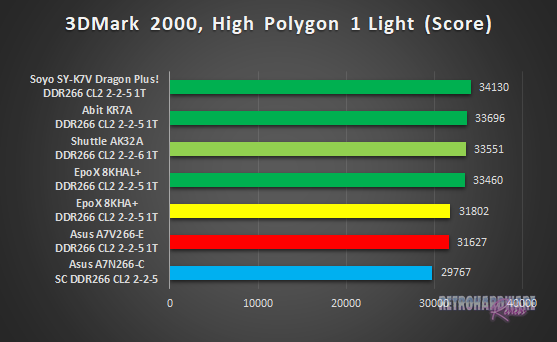
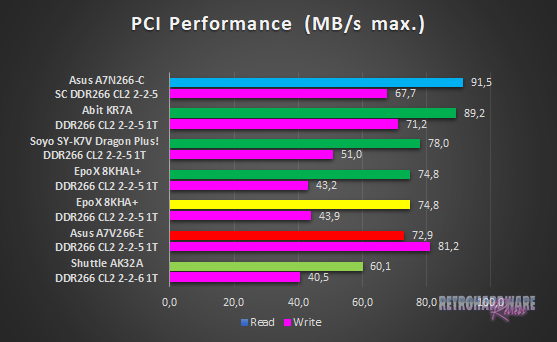
The score in the 3DMark2000 sub-test is the second lowest of all boards with the VIA chipset. It even falls behind its little brother, the EpoX 8KHAL+.
The PCI performance is also rather disappointing, especially the write throughput with around 44 MB/s is pretty low.
Storage Performance: HDTach
To measure the performance of the board's IDE and (if available) onboard IDE RAID solutions' performance, I benched one of the latest and fastest IDE drives (the Hitachi Deskstar T7K500 500GB) with the HDTach benchmark. I also tried a much more “recent” drive (the Western Digital Blue Edition 500GB), which should be even faster in theory, but the Hitachi drive produced much better results in this test.
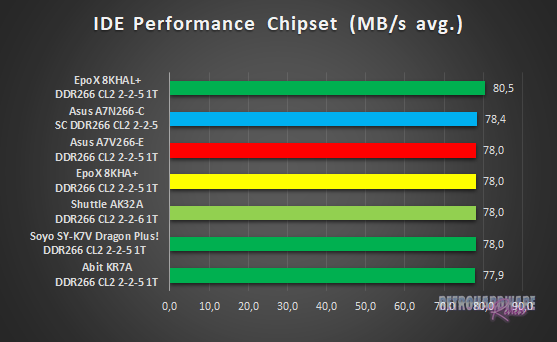
All boards perform very similar with the harddisk connected to the chipset's IDE ports. The KT266A based boards with the older VT8233 southbridge reach exactly (or almost, in case of the Abit KR7A) 78 MB/s, the nForce-based Asus A7N266-C is on a similar level with 78,4 MB/s. Only the Epox 8KHAL+ with the newer VIA VT8233A southbridge squeezes more than 80 MB/s out of the drive.
Gaming Benchmarks
Now that we got all the theoretical performance numbers, let's see how the contenders perform in 3D gaming benchmarks.
3D Performance: 3DMark99max
3DMark99max was released in early 1999 and comes without support for Hardware TnL. The maximum supported (hardware-) DirectX level is DX6. It is a great benchmark to reveal good overall system performance, as it rewards good memory bandwidth and latency more than the slight clockspeed advantage, that some boards have because of their factory-overclocked FSBs.
- Version: "latest"
- Settings: standard
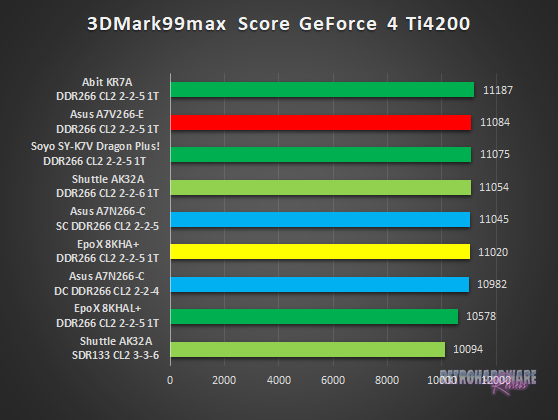
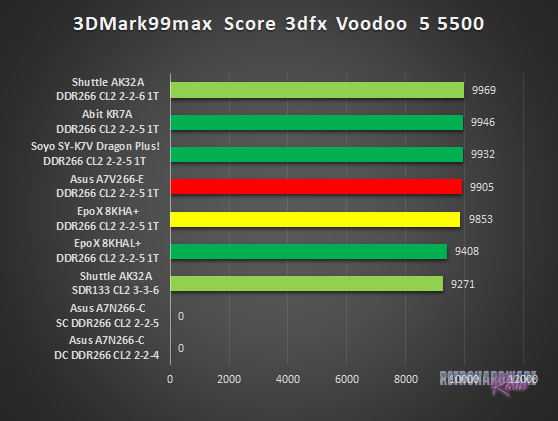
Even though the results in 3DMark99max aren't too far apart with both graphics cards, we see a similar trend in both cases. The 8KHA+ shows the second lowest score of all KT266A boards tested (without taking the AK32A with SDR memory into account), with more than a hundred points behind the top scoring board in both tests.
With the GeForce 4 Ti installed it shows similar performance to the nForce based Asus A7N266-C.
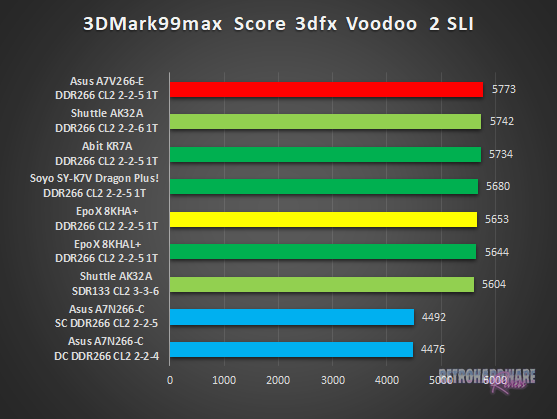
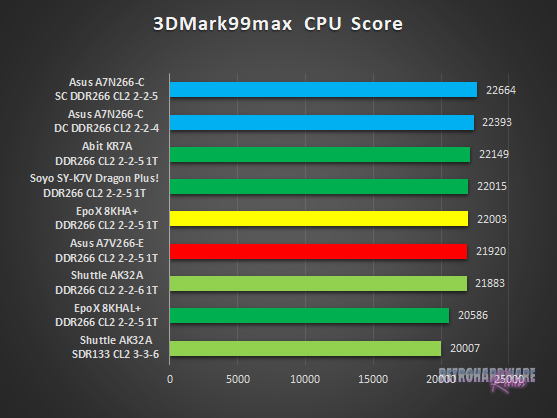
The trend seen with the GeForce 4 Ti and Voodoo 5 before continues - the results of all KT266A boards are pretty close, but the 8KHA+ is one of the slowest boards. It is more than a hundred point behind the fastest board and only around 50 points ahead of the Shuttle AK32A with SDR memory.
The 3DMark CPU score results look a bit better, the EpoX board is able to beat the A7V266-E and the Shuttle AK32A here and comes close to Soyo's K7V Dragon Plus!.
3D Performance: Unreal Tournament (UT99) Timedemo(s)
Unreal Tournament (UT99) was released in November 1999 and is notorious for its hunger for CPU power. I chose to use two different timedemos for comparison, of which the utbench.dem timedemo is heavily CPU bound and therefore qualifies to measure the general performance of the boards. The second timedemo benchmark.dem is as GPU limited as possible in this game. This will reveal, how much impact a faster board can still have in more GPU limited situations. This game is also perfect to show, on which chipsets and boards Voodoo 2 cards run best.
- Version: 4.36
- Settings: High, Min desired Framerate "0", Show Decals [x], Use Dynamic Lightning [x]
- Geforce: D3D
- Voodoo 2 and Voodoo 5: Glide
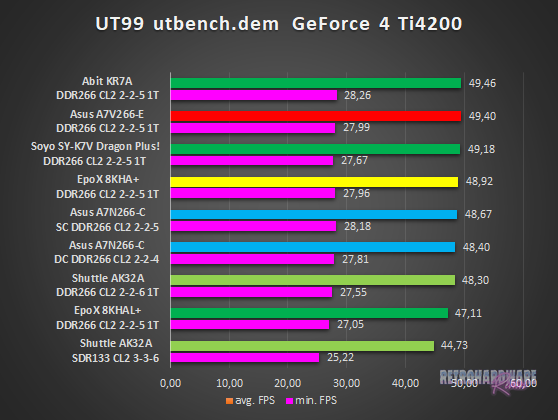
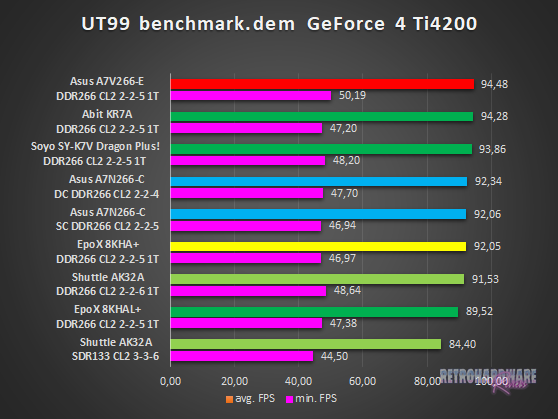
In Unreal Tournament, we see pretty good performance around the level of the A7N266-C in both timedemos. However, the KT266A boards of Asus, Abit and Soyo, are faster in both cases.
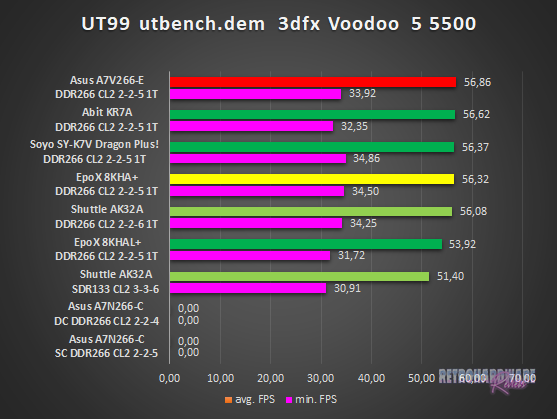
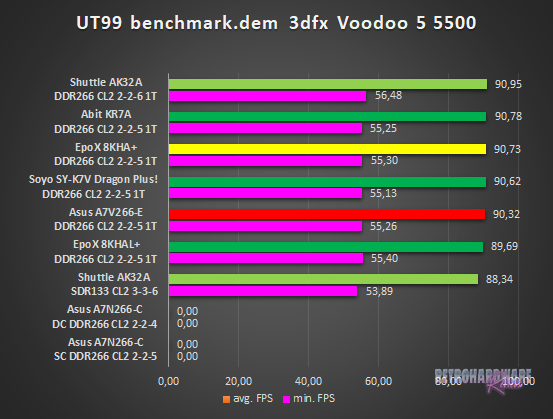
With the Voodoo 5 installed, the 8KHA+ shows a strong performance in the CPU limited utbench timedemo, with an average framerate close to the top performing boards and the second highest minimum framerate of all boards.
In the benchmark.dem timedemo it achieves third place, with all boards (with DDR memory equipped) showing essentially the same level of performance.
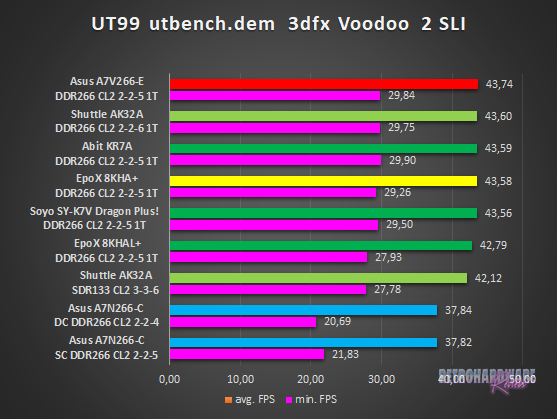
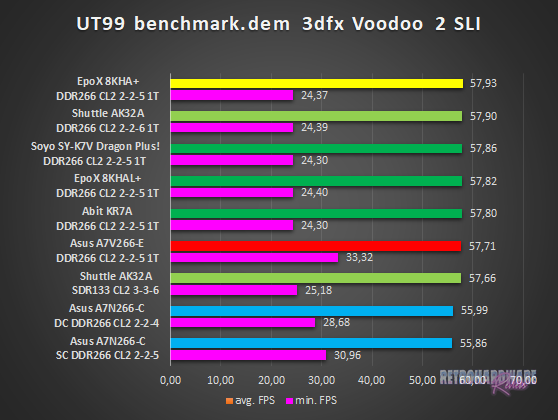
The results with the Voodoo 2 cards installed are very close in both timedemos. The EpoX 8KHA+ ranks fourth and first here, but the performance is very similar among the top scoring boards in both timedemos.
3D Performance: Quake III Arena Timedemo
Quake 3 Arena was released shortly after Unreal Tournament, in December of 1999. It is known to reward fast memory latency and with its normal preset, it is completely CPU limited; at least for the GeForce 4 and the Voodoo 5. The Voodoo 2 SLI cards clearly limit the Athlon 1200 here, as the timedemo will show.
- Version: 1.32
- Settings: “Normal” Preset, only resolution changed to 1024x768x16
- Geforce 5 and Voodoo5: OpenGL
- Voodoo 2: “Voodoo” Renderer (miniGL)
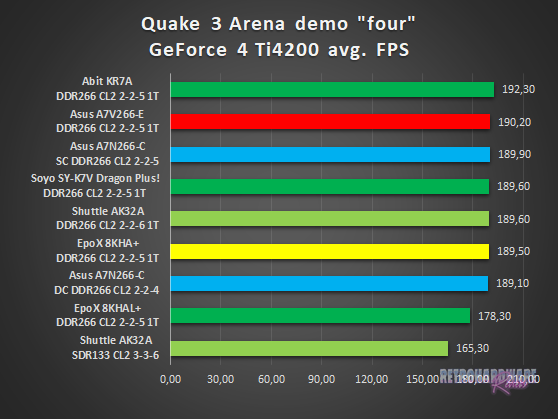
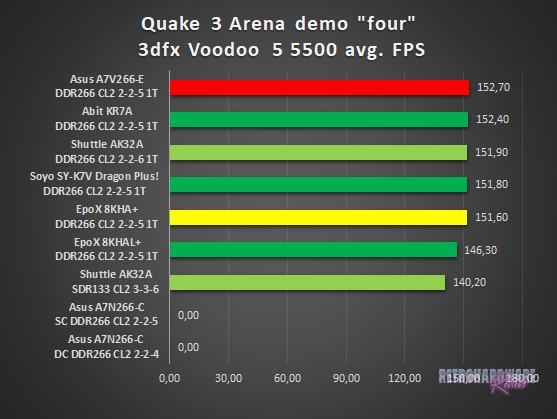
In Quake III Arena, we see a return of what we saw in the results of the 3DMark99max benchmark for both GeForce 4 Ti and Voodoo 5: The 8KHA+ is not far behind the top scoring boards, but still it shows the second lowest scores of all KT266A boards tested.
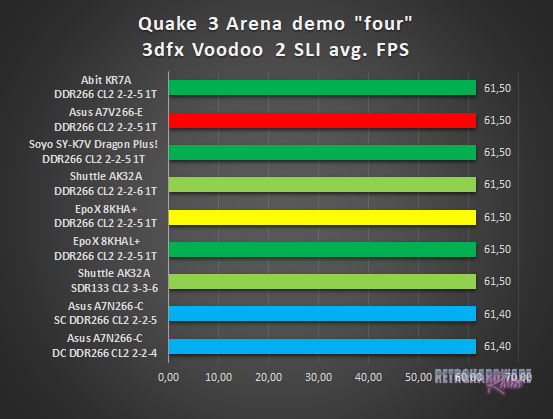
The Voodoo 2 SLI setup clearly limits here. All KT266A based boards score the same FPS, the nForce board is also just 0,1 FPS behind.
Summary & Rating
EpoX EP-8KHA+ (VIA KT266A)
-
Layout
-
Features
-
Overclocking Options
-
Compatibility
-
Documentation & Support
-
Performance: GeForce 4 Ti 4200
-
Performance: Voodoo 5 5500
-
Performance: Voodoo 2 SLI
OVERALL
| Pros | Cons |
| + Great CPU support | – Bad ATX connector position |
| + Good overall performance | – Rather low PCI performance |





